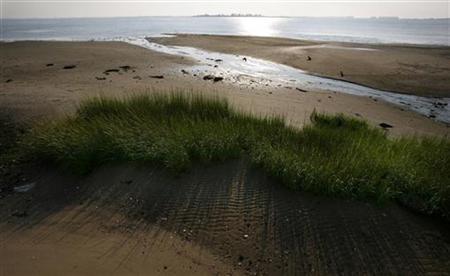Date: 19-Jan-09
Country: US
Author: Jasmin Melvin
Rising Sea Levels Threaten East Coast Photo: Mike Segar
A strip of marsh is seen along Jamaica Bay's eastern shore off the Gateway National Recreation Area National Park in the Brooklyn section of New York City, August 3, 2007.

Photo: Mike
Segar
WASHINGTON - Sea levels on the United States' mid-Atlantic coast are rising
faster than the global average because of global warming, threatening the
future of coastal communities, the Environmental Protection Agency said on
Friday.
Coastal waters from New York to North Carolina have crept up by an average
of 2.4 to 4.4 millimeters (0.09 to 0.17 inches) a year, compared with an
average global increase of 1.7 millimeters (0.07 inches) a year, the EPA
said in a report.
As a result, sea levels along the East Coast rose about a foot over the past
century, the EPA's report, commissioned by the Climate Change Science
Program, said.
The EPA focused on the mid-Atlantic region because it "will likely see the
greatest impacts due to rising waters, coastal storms, and a high
concentration of population along the coastline," the agency said.
Higher sea levels threaten to erode beaches and drastically change the
habitats of species in the area, often at a pace too fast for species to
adapt and survive, the EPA said.
Communities in the area are at greater risk of flooding as a "higher sea
level provides an elevated base for storm surges to build upon and
diminishes the rate at which low-lying areas drain," the report found.
Floods will probably cause more damage in the future as higher sea levels
gradually erode and wash away dunes, beaches and wetlands that serve as a
protective barrier. Consequently, homes and businesses would be closer to
the water's edge.
Rising sea levels have implications beyond the mid-Atlantic region, the
report said.
Ports challenged by rising waters could slow the transport of goods across
the country, and disappearing beaches could hurt resorts and affect tourism
revenue, the EPA said, damaging an already fragile U.S. economy.
"Movement to the coast and development continues, despite the growing
vulnerability to coastal hazards," the EPA said.
Scientists have said the rate sea levels are rising has accelerated. By the
end of the century, global sea levels could be seven to 23 inches higher,
the Intergovernmental Panel on Climate Change has predicted.
Federal, state and local governments should step in now to prepare for the
rising seas, said the EPA along with the National Oceanic and Atmospheric
Administration and the U.S. Geological Survey, who contributed to the
report.
Governments should protect residents through policies that preserve public
beaches and coastal ecosystems and encourage retrofits of buildings to make
them higher, the agencies said.
Engineering rules for coastal areas used today are based on current sea
levels and will not suffice in the future, the report said.
Flood insurance rates also could be tweaked to accommodate risk from rising
sea levels, the report said.
(Editing by Marguerita Choy)
© Thomson Reuters 2009 All rights reserved
